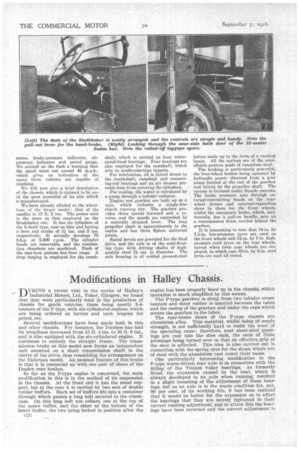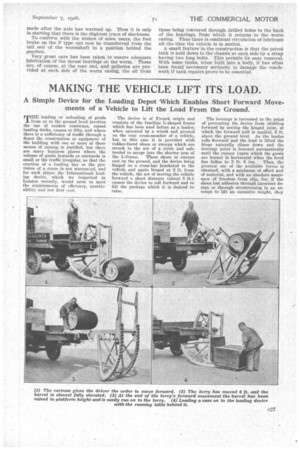Modifications in Halley Chassis.
Page 48

Page 49

If you've noticed an error in this article please click here to report it so we can fix it.
DURING a recent visit to the works of Halley's Industrial Motors, Ltd., Yoker, Glasgow, we found that they were particularly busy in the production of chassis for goods vehicles, these being mostly 3-4tonners of the P type, with six-cylindered engines, which are being ordered as lorries and tank wagons for petrol, etc.
Several modifications have been made both in this and other chassis. For instance, the Ivanhoe has had its wheelbase increased from 15 ft. 4 ins. to 10 ft. 9 ins., and is also equipped with the six-cylindered engine. It continues to embody the straight frame. The transmission brake on this model now forms an independent unit mounted on a short transmission shaft in the centre of the drive, thus resembling the arrangement on the Talisman model. An unusual feature of this brake is that it is connected up with one pair of shoes of the Duplex rear brakes.
So far as the P-type engine is concerned, the main modification in this is in the method of its suspension in the chassis. At the front end it has the usual support, but at the rear it is carried by two sets of double rubber buffers. Each set of buffers fits into a container through which passes a long bolt secured to the crankcase. On this long bolt are collars, one at the top of the upper buffer, and the other at the bottom of the lower buffer, the two being locked in position after the c20 _ engine has been properly lined up in the chassis, which operation is much simplified by this means. The P-type gearbox is slung from two tubular crossbearers and sheet rubber is inserted between the tubes and the casing of the gearbox and under the caps which secure the gearbox to the tubes.
The rear-brake shoes of the P-type chassis are aluminium alloy. This material, whilst being of ample strength, is not sufficiently hard to resist the wear of the operating cams ; therefore, neat sheet-steel pressings are cast into the shoe ends, the ends of these pressings being turned over so that an effective grip of the shoe is afforded. This idea is also carried out ;n connection with the spring eyes for the shoes, which are of steel with the aluminium cast round their bases.
One particularly interesting modification in the P-type worm-driven rear axle is in connection with the fitting of the Timken roller bearings. As formerly fitted, the expansion caused by the heat, which is always developed in an axle when running, resulted in a slight loosening of the adjustment of these bear; ings, but as an axle is in the warm condition for, say, 90 per cent. of its working life, it has been realized that it would be better for the expansion so to affect the bearings that they are merely tightened to their correct running adjustment, and to attain this the bearings have been reversed and the correct adjustment i., made after the axle has warmed up. Thus It is only in starting that there is the slightest trace of slackness.
To conform with the wishes of some users, the foot brake on the P type can now be transferred from the tail end of the wormihaft to a position behind the gearbox, Very great care has been taken to ensure adequate lubrication of the thrust bearings on the worm. These are, of course, at the rear end, and galleries are provided at each side of the worm casing, the oil from these being conveyed through drilled holes to the back of the bearings, from which it returns to the worm casing. Thus there is continual circulation of lubricant all the time the vehicle is in motion.
A small feature in the construction is that the petrol tank is held down to the chaSsis at each side by a strap having two long bolts. This permits its easy removal. With some tanks, when built into a body, it has often been found necessary seriously to damage the coachwork if tank repairs prove to be essential.












































































































